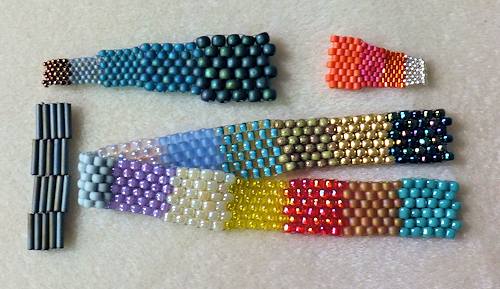Seed Beads Reload – Video of Sizes and Colors
I’ve had a post previously about seed bead sizes and colors. This is an update, because seed beads are a moving target! In this post, we’ll talk a little more about seed beads, and a little further down, I have a video so you can perhaps better get an idea of some of the sizes and colors that are available.
I’ll also talk about the shapes of seed beads — traditional, cylinder, charlotte and bugle. (I’ll do a separate post on all the other neat shapes available these days.)
Seed Bead Shapes
First, you need to know shapes. Why you may ask? Glad you asked, because not all seed bead shapes are good for all bead weaving stitches. Let me rephrase that — some shapes are better than others for certain beading stitches. Each shape has their pros and cons, so let’s get started.
Traditional Round
These are your doughnut shaped beads. There are two main origins for these beads — Japan and the Czech Republic. In general, the Japanese beads are a bit more consistent in shape and hole size. They also come in far more colors. The Czech beads come in fewer colors and are more irrecgular. However, this is changing, because I am seeing some gorgeous multi-colored beads coming out of the Czech Republic.
Whenever you see “seed beads” in a supply list, unless specified differently, it generally means the traditional rounds.
The traditional round beads are good with any beading stitch. Keep in mind the variations of the individual beads — depending on your project, you may need to sort through your beads and take out the ones that are noticeably larger, smaller or more irregular.
Cylinder
These are usually known as “Delica” and are made by Miyuki in Japan. However, Toho (also Japan) makes a cylinder bead as well, called “Aiko”. They are both very regular in size and shape.
Cylinder beads are like teeny-tiny tubes. They also have a larger hole than do similarly-sized round beads. The cylinder beads are slightly smaller than the traditional round — a size 11 Delica or Aiko is more like a size 12 traditional round bead.
Best uses for cylinder beads are stitches like peyote, brick, ladder and square. They aren’t as good for herringbone or right angle weave.
Charlotte
The vast majority of the charlotte beads come from the Czech Republic, but Miyuki also makes some charlottes. This kind of seed bead is characterized by a single facet cut into one side of the bead. They are also typically irregular in shape…which makes them a great choice for organic looks!
Charlotte beads are typically very small — sizes 12, 13 and 15 – although I have rn across some size 8 charlottes. The holes are tiny in the beads coming out of the Czech Republic, and a slight bot larger in the Miyuki beads. Don’t expect to get all that many passes with a needle and thread through these seed beads.
You can use charlottes anywhere you use the traditional round beads, as long as you either use a very fine needle and thread, or use a stitch that doesn’t involve a lot of passes through the beads.
Bugle
Bugles have been around for quite awhile, and they have definitely evolved over time. These are cylinders to the max, so to speak — thin tube-shaped beads.
As for colors, don’t expect a huge range. You should find all the “usual colors”, but there are a lot of more specialized colors that aren’t available.
Bugles can be readily used in peyote, square, brick and ladder. Not so much the others, except for special effects.
Time for the Video
I’ve gone on quite a bit just on the different kinds of “regular” seed beads, so I won’t go into colors in this post. You’ll be able to see good examples in the video.
One kind of color finish I didn’t mention in the video is dyed. There are some absolutely gorgeous dyed colors in seed beads, but avoid them unless your piece will not be handled. And won’t get wet or sit in bright sunlight. Yes, the color wears off, and can bleed.
Although I say it in the video, it bears repeating — if you are buying galvanized beads, look for those marked as permanently galvanized (also sometimes called “permanent finish”). Don’t buy the regular ones –the beautiful metallic coating will rub off, probably the first time you wear your jewelry. Permanently galvanized beads hold up very well, though.
That’s it for now — stay tuned for the video on the myriad new shapes of seed beads — triangles, drops, cubes and the cool two-hole beads (to mention a few).
Leave a Reply